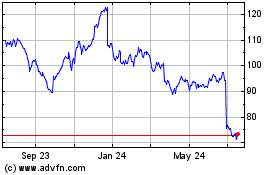Dow 20000: Nike Is Missing Out -- Ahead of the Tape
December 19 2016 - 3:20PM
Dow Jones News
By Steven Russolillo
In the Dow Jones Industrial Average's march to 20000, Nike Inc.
is conspicuously absent.
The retail giant is one of only two blue-chip stocks that are
down in 2016. And it is the worst performer, off 19% this year and
down by roughly one-quarter since peaking in November 2015. The
worry is that changing fashion trends and intensifying competition
are eating away at Nike's global dominance.
But the stock rarely stays this depressed for long. And after
several lackluster quarters, Wall Street has uncharacteristically
lowered the bar for Nike heading into Tuesday's earnings report,
possibly providing a rare buying opportunity for this
highflier.
Analysts expect fiscal second-quarter earnings of 43 cents a
share, an estimate that was as high as 52 cents over the summer.
The lowered consensus forecast is the first time in at least a year
that Nike analysts have cut their views prior to an earnings
report, according to FactSet.
The worries aren't without merit, of course. Rivals such as
Adidas AG, Under Armour Inc. and Lululemon Athletica Inc. continue
to encroach on Nike's turf. But Nike is no stranger to competition.
Its shares have had only six down years over the past three
decades. The only time that they ever dropped in consecutive years
was in 1983-84, when it was losing market share to then-upstart
Reebok.
Even then, the tough times didn't last long. Nike shares
accumulated six consecutive years of double-digit percentage growth
through the early 1990s. And overall, the stock has gained 15%
annually since its initial public offering 36 years ago, nearly
double the pace of the S&P 500.
For Nike to get back on the right foot, it must prove to
investors that it has a plan to fend off its rivals. A tweak to its
earnings release could offer it that chance. Tuesday's release will
mark the first time Nike won't report so-called futures orders in
its quarterly report.
The stock often traded on this metric as opposed to top- or
bottom-line growth. But Nike said future orders don't mean as much
as they once did because the company is selling more items directly
to consumers either through its retail outlets or online. Sure
enough, sales guidance in recent years has typically been a better
predictor of sales growth than future orders. Nike has said it
would still discuss futures orders on conference calls with
analysts and in regulatory filings.
Nike also has a compelling valuation on its side. It fetches 20
times projected earnings, its cheapest multiple since 2013.
Had Nike shares just been flat this year, the price-weighted Dow
would be about 80 points higher than it is now. Investors who "just
do it" might finally help spur the long-awaited Dow 20000
celebration.
(END) Dow Jones Newswires
December 19, 2016 15:05 ET (20:05 GMT)
Copyright (c) 2016 Dow Jones & Company, Inc.
Nike (NYSE:NKE)
Historical Stock Chart
From Aug 2024 to Sep 2024

Nike (NYSE:NKE)
Historical Stock Chart
From Sep 2023 to Sep 2024
